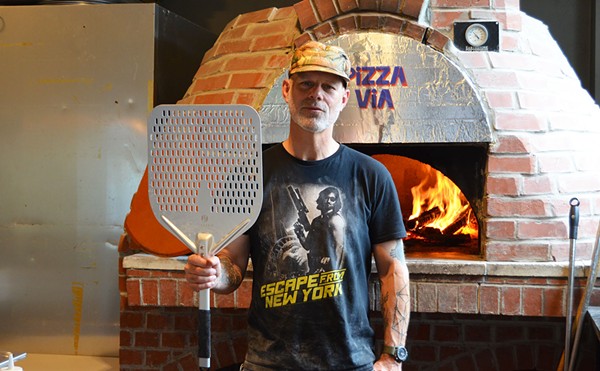Around the dining room, expansive enough to seat parties of up to 180 people, decorations from a wedding reception the weekend before remain: sheaths of white crepe paper and powder-blue ribbon strung along the walls and between ceiling fans, accented by big, puffy blue bows. Each table is topped by a maroon vinyl tablecloth and a vase holding white carnations and sprigs of baby's breath, which have turned a matching shade of blue by the food coloring put in their water.
Marion is not going home any time soon. New Orleans -- or, as she will refer to it at one point this evening, "what used to be New Orleans" -- was her birthplace, the place where she was raised and taught to cook. Six months ago, her eight-year-old Marion's St. Louis Rib Co. moved from its original home, a ramshackle Delmar shopfront that was about to be gutted and rehabbed, into these fresh-scrubbed new quarters, with tall, plate-glass windows, a loft-like ceiling with exposed ductwork, and tidy, red-lettered signage. Those old digs Marion had no problem saying goodbye to. The space only sat twenty customers, and the building had no heating or cooling system. Besides heat from the ovens and a few electric space heaters, her recommended form of warmth was to "stand close to the guy next to you."
Marion's also not going home soon because she is always, always at her soul food-Cajun-rib joint. The morning shift means breakfast: egg, bacon or sausage sandwiches on toast for quick to-go meals, waffles and pancakes, and the three house-named eggs/bacon/hash browns/toast combo platters. There's also catering to get started on; Marion estimates that half of her intake comes from birthday parties, anniversary celebrations, weddings, and Washington University student functions. At lunch, lots of men stop in for a tripe sandwich or snoot with potato salad, and then comes the onslaught of rib orders for dinner. On an average day, Marion goes through six gallons of her made-daily barbecue sauce and seven whole caramel cakes, sold off by the slice.
At Marion's, you really can go home again -- whether you're a regular at an establishment where everybody knows your name, a transplanted New Orleanian wondering what will be left of the place you once knew, or simply a fan of the kind of food that emphasizes the flavors of a specific hometown's cooking, while tasting like a shared, universal idea of home should.
Like the unsystematic cultural fabric of New Orleans itself -- a former penal colony, a city fought over by the French and the Spanish and the origin point of the Creoles -- Marion's culinary style mishmashes a little Creole with Cajun, Cajun with soul food, New Orleans-style ribs with St. Louis-style ribs. Her cornbread is prepared flat and round, like flapjacks. A little bit moister and a whole lot denser than typical dry, crumbly cornbread squares, these would make a great substitute for the toast in her breakfast sandwiches. This is hot-water cornbread, a real Southern specialty in which the cornmeal is fried in fat in a skillet rather than baked. It comes alongside many of the "Cajun Corner" dinners, like a melt-in-your-mouth catfish filet or half a baked chicken served over rice and accompanied by stir-fried vegetables (water chestnuts, baby corn, broccoli, etc.) ladled with brown gravy, a side that outshines the output at many a Chinese place around these parts.
Marion's barbecue doesn't come with cornbread; instead, it's served with plain, untoasted slices of Wonder Bread. Sandwich orders, such as a beef-rib sandwich or a hot smoked-sirloin sandwich, employ Wonder Texas toast, while full-dinner plates (paired with a couple of sides, like tangy-starchy black-eyed peas, smoky-mustardy collard greens or syrupy-sweet candied yams) rely on plain old sandwich slices. Wonder Bread is an excellent, excellent product to eat alongside barbecue. The bread's squishy texture goes great with the tender meat; its slight trace of sweetness complements the barbecue sauce just so.
On the menu's front cover, Marion's ribs are dubbed the "Best Ribs Ever." This is true. They are perfect, impeccable, unassailable, drenched thick with clingy sauce (made in mild, sweet and hot varieties). For carnivorous adults, these ribs are the equivalent of lollipops or candied apples: wipe-your-mouth-with-the-back-of-your-hand good.
To pry into just how Marion turns out such truly stupendous food would be like toying with the voodoo spirits that have haunted New Orleans for centuries. Other cuisines are meant to be dissected in Parisian-accented French, studied at white-hat culinary-schools, and tweaked for show within the kitchens of coastal and Continental four-star palaces. Marion's is about the basic stuff of life: food as love, sustenance both physical and spiritual, the guttural rather than the intellectual. Why bother recounting the step-by-step? Few could do it this good anyway, even knowing all her secrets.
Like the secret to cooking up a pig's snout until it becomes snoot. The meat and skin have got to be rendered, a cooking term for melting animal flesh over a low flame until the fat melts away and just the connective tissues remain. Snoot, once rendered, is similar to pork rinds or cracklings, but thicker and, at times, tougher. (Also, each hair follicle on the pig's nose is still intact and visible.) Snoot's texture can waver from mouthful to mouthful: bone-hard on one bite, and on the next, crunchy like a wafer cookie from where the fibers have morphed into rows of sinewy striations. (Another reason Marion was a bit out of sorts that night at her restaurant -- she'd chipped a tooth earlier chomping down on a piece of snoot.)
Moving into her new space, larger both in front and in back, gave Marion leeway to up her production of desserts, which are just as incredible and sinful as her ribs. Sweet potato pie, with its rich burnt-orange hue, comes off like pieces of spiced, firm, homemade pumpkin pie, minus all the off-putting pumpkin pulp. Caramel cake boasts icing so sweet that the sugar crystals make a sound when you bite through them. Marion's two puddings bear scant resemblance to Mr. Cosby's Jell-O. Bread pudding is done proper, like a slice of cake, with a gooey interior akin to that of pecan pie. Banana pudding is a firm-yet-gelatinous mound of mashed-banana goo, like a half-baked, milk-drenched pile of banana cake batter, topped with scraps of meringue and cream.
The relocated Marion's sits on the very same block as the original. Yet Marion claims that many of her regulars have had a dickens of a time finding her again. The new signage isn't catching people's eyes, apparently. "I seemed to be lost for a while," she says. "Nobody knew where to find me." But even in a new house, Marion is where she has always been: right at home.





